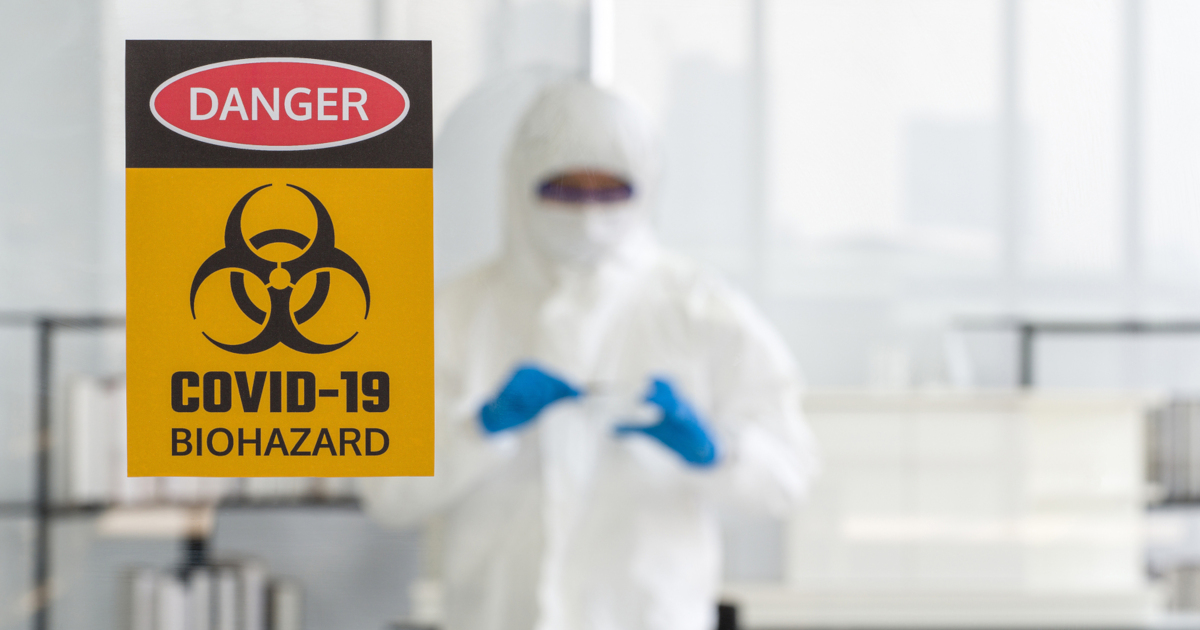Petition: Ban Bioweapons Labs
SIGN THE PETITION: Stop the Genetic Engineering of Viruses! Shut Down All Biowarfare Labs Now!
Demand an Immediate Global Ban on Gain-of-Function ‘Biomedical’ and ‘Biodefense’ Research!
As the global COVID-19 death toll mounts, the debates rage on. Masks, or no masks? This drug, or that one? Send kids to school, or keep them home?
Yet absent from most of the day-to-day mainstream coverage of COVID-related issues is the life-or-death conversation we should be having: How do we make sure that this—or something much worse—never happens again?
On that question, there should be no debate: It’s time to end the reckless genetic engineering and weaponizing of pathogenic viruses and organisms, carried out under the guise of “biomedicine” and “biodefense,” by demanding an immediate and total global ban all gain-of-function research.
SIGN THE PETITION: Demand an Immediate Global Ban on Gain-of-Function ‘Biomedical’ and ‘Biodefense’ Research!

Unbeknownst to the vast majority of U.S. citizens, hundreds of millions of taxpayer dollars are granted to scientists, working in labs around the world, to tinker with viruses, bacteria and microorganisms for one purpose: to make them as infectious and as deadly as possible to humans, especially our most vulnerable populations.
The work is called gain-of-function research. In the case of COVID-19, this type of research involved taking a bat virus, and through genetic engineering and/or animal experiments, intentionally making that virus highly infectious and highly transmissible to humans.
Why spend money, time and valuable brainpower creating viruses that have the potential to wipe out millions of people?
It’s a good question. One that many scientists, at least the sane ones, are hard-pressed to answer.
Gain-of-function research is most often justified as either “biomedical” or “biodefense” research. But neither of those justifications hold up under the scrutiny of scientists who are familiar with gain-of-function experiments.
‘One of the gravest threats we face’
Let’s start first with the “biodefense” rationale—which as bioweapons expert Sam Husseini explains, is just a euphemism for biowarfare:
“Governments that participate in such biological weapon research generally distinguish between ‘biowarfare’ and ‘biodefense,’ as if to paint such ‘defense’ programs as necessary. But this is rhetorical sleight-of-hand; the two concepts are largely indistinguishable. ‘Biodefense’ implies tacit biowarfare, breeding more dangerous pathogens for the alleged purpose of finding a way to fight them. While this work appears to have succeeded in creating deadly and infectious agents, including deadlier flu strains, such ‘defense’ research is impotent in its ability to defend us from this pandemic.”
Since the technology was developed, genetic engineering has played a central role in U.S. and international biowarfare.
Michael J. Ainscough, in a 2002 paper titled: “Next Generation Bioweapons: The Technology of Genetic Engineering Applied to Biowarfare and Bioterrorism,” wrote that the “history of warfare and the history of disease are unquestionably interwoven.”
Ainscough, a medical doctor, Air Force flight surgeon and one-time diplomat of the American Preventive Medicine in Aerospace Medicine, argued that “organisms with altered characteristics are the ‘next generation’ of biological weapons:
“In this century, it is widely predicted that advances in biology and biotechnology will revolutionize society and life as we know it. At the same time, [this technology], which can be used to create biological weapons, will be one of the gravest threats we will face.”
Genetic engineering technology has evolved since Ainscough wrote on the subject two decades ago. Today, scientists warn that the newer gene-editing and synthetic biology technologies pose even greater risks in the realm of biowarfare.
Toby Ord, senior research fellow at Oxford University’s Future of Humanity Institute, told GM Watch that the risks posed by these newer gene editing technologies are among “the highest existential threats we face.” As GM Watch reports:
“Ord’s concerns about gene editing being used to genetically modify a pathogen are shared by the U.S. intelligence community. In fact, in 2016, the technique was added to the list of ‘weapons of mass destruction and proliferation’ by the top U.S. intelligence official for this very reason. The late Stephen Hawking also thought the genetic engineering of viruses had created the risk of a lethal ‘own goal.’ And by ‘lethal’ he meant not just as deadly as the current pandemic, but something that could make the planet completely uninhabitable for humans.”
‘Research that panics people, without actually learning much—if anything’
The other rationale for gain-of-function research, “biomedical” research, sounds less nefarious. But it ranks low on both the plausibility and ethics scales.
In 2017, after learning that the Trump administration had lifted the “pause” on gain-of-function research that had been instituted under Obama (in 2014), Marc Lipstich, an epidemiologist who directs the Center for Communicable Disease Dynamics at the Harvard School of Public Health, spoke out.
Lipsitch told the New York Times that recent gain-of-function experiments “have given us some modest scientific knowledge and done almost nothing to improve our preparedness for pandemics, and yet risked creating an accidental pandemic.”
In a recent interview with Organic Consumers Association, Jonathan Latham, who has a PhD in virology and directs the Bioscience Resource Project, said this about the risks vs. the benefits of gain-of-function research:
“You’ve shown that you can make a pandemic-type virus in the lab. But on a global scale, it is potentially disastrous but a scientifically trivial demonstration. These people are doing research that panics people, without actually learning much—if anything.”
So why create a “pandemic-type virus” in a lab, if the risks far outweigh the benefits?
The public-facing rationale, Latham suggests, is this: By creating highly transmissible, potentially deadly (on a massive scale) viruses in a lab, researchers can study how to respond should such a virus ever evolve in nature and infect humans.
But Latham rejects that argument. Why? Because it involves a whole lot of guessing about how a virus might evolve in nature:
“People can say they’ve made a pandemic virus in a particular set of cells, that’s their scientific finding, and that’s what they publish. But the natural world doesn’t say that it has to evolve in those kinds of cells. It could come from a different species via another backbone, with a different spike. Are they going to do these experiments forever? Creating pandemic viruses, simply to generate research funds?”
And that, suggests Latham—the prospect of landing huge government grants—is the primary motivation for most gain-of-function research. Even though that research could potentially wipe out a huge percentage of the human race, in return for little if any benefit.
‘Hundreds of accidents, safety violations and near-misses’
The risks scientists assign to gain-of-function research are grounded in facts, not speculation. Labs, including in the U.S. and China, have poor track records when it comes to ensuring that potentially lethal, genetically engineered viruses won’t escape.
“Inside America’s Secretive Biolabs,” an investigative report published in May 2015 by USA Today, revealed reports of hundreds of accidents, safety violations and near-misses at biosafety labs—and that was just in the U.S. (In April of this year, the Washington Post reported on memos relating to safety lapses at the Wuhan Virology Lab, in Wuhan, China, the lab where COVID-19 was most likely created).
A follow-up USA Today news report on biolab safety issues, published in June 2016, prophetically likened the combination of risky gain-of-function research and lax safety measures to a “screenplay for a disaster movie.”
In October 2019, the Johns Hopkins Bloomberg School of Public Health published the Global Health Security Index, which warned of the “increased potential threat of accidental or deliberate release of a deadly engineered pathogen, which could cause even greater harm than a naturally occurring Pandemic.”
The report also concluded, prophetically, that most countries, including the U.S., are woefully ill-prepared to address pandemics.
Scientists sounded alarms, years before COVID-19
In July, 2014, 327 international scientists signed a consensus statement calling for a moratorium on gain-of-function research, or what the group called “Potential Pandemic Pathogens.”
Citing biolab safety lapses, the Cambridge Working Group wrote:
“For any experiment, the expected net benefits should outweigh the risks. Experiments involving the creation of potential pandemic pathogens should be curtailed until there has been a quantitative, objective and credible assessment of the risks, potential benefits, and opportunities for risk mitigation, as well as comparison against safer experimental approaches.”
The Obama Administration took note, and in October 2014, shut down all U.S. funding for new gain-of-function research pending a thorough risks-benefits analysis.
But some gain-of-function research projects already in progress were allowed to continue. And then in December 2017, under the Trump Administration, the National Institutes of Health lifted the moratorium, paving the way for U.S. taxpayers to once again fund research that some scientists believe poses an existential threat to life on earth.
‘Exquisitely designed to infect humans’
Despite widespread efforts to convince a concerned public that COVID-19 occurred naturally, jumping from a bat, perhaps through a pangolin, eventually to humans, that narrative doesn’t withstand the scrutiny of scientists who have been studying, and opposing, gain-of-function research for decades.
Even the Chinese government has now admitted that COVID-19 did not arise from the Seafood Market in Wuhan, China.
In May, a team of Australian scientists studied COVID-19 and concluded that the virus targets humans more potently than any of the tested animal species. The study’s lead author, Nikolai Petrovsky, told one media outlet that COVID-19 is “exquisitely adapted to infect humans.”
GM Watch recently reported that Rutgers University Professor Richard Ebright, a biosecurity expert who has been speaking out on biosafety issues for nearly 20 years, suspects an accidental lab release led to the COVId-19 pandemic.
Stuart Newman, professor of cell biology and anatomy at New York Medical College in Valhalla, New York and co-author of Biotech Juggernaut, referred GM Watch to papers going back 20 years on engineering coronaviruses. Newman told GM Watch:
“Even most biologists are not aware that virologists have been experimentally recombining and genetically modifying coronaviruses for more than a decade to study their mechanisms of pathogenicity.”
Given the evidence, given the warnings, given that the risks far outweigh the benefits and given the urgency, all governments should immediately shut down gain-of-function experiments.
Sign the Petition
First nameLast nameEmailZIP CodePhoneSIGN HERE
PETITION
I call on the U.S. and all world governments to stop funding and to immediately shut down all Gain of Function research, including the genetic engineering of viruses.
A growing number of scientists and experts now believe that COVID-19 originated in a lab, likely in Wuhan, China, as the result of gain-of-function experiments.
Scientists have been conducting gain-of-function research for decades, despite warnings about the risks,
Food First

In April, when we were still grappling with the mere idea of a pandemic, Mercola.com published an article on how best to defeat the coronavirus: Fix your health, by fixing your diet.
Last week the Federal Nutrition Research Advisory Group published a white paper echoing that advice, and going so far as to conclude that Americans’ diets are so poor, they threaten U.S. security:
“Stark national nutrition challenges were identified. More Americans are sick than are healthy, largely from rising diet-related illnesses. These conditions create tremendous strains on productivity, health care costs, health disparities, government budgets, US economic competitiveness, and military readiness. The coronavirus disease 2019 (COVID-19) outbreak has further laid bare these strains, including food insecurity, major diet-related comorbidities for poor outcomes from COVID-19 such as diabetes, hypertension, and obesity, and insufficient surveillance on and coordination of our food system and national security.”
The Mercola article cited early studies of COVID-19 patients revealing that underlying health conditions like heart disease and diabetes are linked to “poorer clinical outcomes,” such as admission to an intensive care unit (ICU), a need for invasive ventilation or death.
As the pandemic rolls on, and new studies emerge, some early observations remain just as relevant four months later: Diabetes in particular puts patients at high risk for infection and poor outcomes.
If ever there were a time to take control of your health, to address your diabetes or other diet-related health problems, now would be that time. This article goes in-depth into the why—and more importantly, the how. Starting with food.
Read ‘Want to Defeat Coronavirus? Address Diabetes and Hypertension’
SIGN THE PETITION: Stop the Genetic Engineering of Viruses! Shut Down All Biowarfare Labs Now!
MORE ON COVID-19
Watch ‘Bret Weinstein and Yuri Deigin: Did Covid-19 leak From a Lab?’
Read ‘Lab-Made? SARS-CoV-2 Genealogy Through the Lens of Gain-of-Function Research’













